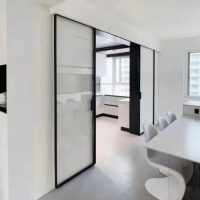
Sliding Door System have become a cornerstone of modern interior design, offering space-saving functionality and an elegant aesthetic. Whether used for room dividers, closet doors, or patio entrances, these systems provide a seamless blend of form and function. We will explore sliding door systems in depth, covering their types, advantages, installation process, maintenance, and design considerations to help you make informed decisions for your living or working space.
Types of Sliding Door Systems
-
Pocket Doors: Pocket doors slide into a hidden wall cavity, completely concealing them when open. They are ideal for space optimization and a sleek, minimalist look.
-
Barn Doors: Inspired by traditional barn doors, this style features a sliding door that hangs from a visible track. Barn doors add rustic charm and can be used as room dividers, closet doors, or even as a focal point in a room.
-
Bypass Doors: Bypass doors consist of two or more panels that slide past each other. They are commonly used for closet doors and are excellent space-saving solutions.
-
Patio Sliders: Patio sliders are large glass panels that slide horizontally to provide access to outdoor spaces. They are popular for their ability to seamlessly merge indoor and outdoor areas.
Advantages of Sliding Door Systems
-
Space Efficiency: Sliding doors do not require the swing space that traditional hinged doors do. This makes them perfect for small rooms or spaces where maximizing square footage is essential.
-
Aesthetic Appeal: Sliding doors offer a modern and stylish design that can enhance the overall aesthetic of a room. They come in various materials, including wood, glass, and metal, allowing for customization to suit your decor.
-
Natural Light and Views: Sliding glass doors, like patio sliders, provide an abundance of natural light and unobstructed views of the outdoors. They can create a seamless transition between your indoor and outdoor living spaces.
-
Sound Insulation: Sliding doors often provide better sound insulation compared to traditional doors, as they create a tighter seal when closed.
-
Accessibility: Sliding doors are easy to operate, making them a great choice for people with mobility issues. They also accommodate furniture and other objects without the risk of door collision.
Installation Process
Installing a sliding door system involves several steps:
-
Measurement: Accurate measurements are essential to ensure the doors fit the opening correctly. Measure both the width and height, as well as the thickness of the walls.
-
Frame Installation: Install the door frame, which includes the header, side jambs, and threshold. Ensure that it is level and plumb, using shims if necessary.
-
Track Installation: Attach the track to the header. The track guides the doors as they slide, and it must be level and secure.
-
Hanging the Doors: Hang the doors on the track, ensuring they glide smoothly. Most sliding door systems use rollers or ball bearings for this purpose.
-
Handles and Locks: Install the handles and locks as per the manufacturer’s instructions. These components provide both functionality and style.
-
Testing: Test the doors to ensure they slide smoothly and close securely. Make any necessary adjustments to the track or rollers.
Maintenance
Proper maintenance is essential to keep your sliding door system in top condition:
-
Regular Cleaning: Clean the tracks and rollers periodically to remove dirt and debris that can impede movement. Use a brush or vacuum cleaner followed by a damp cloth.
-
Lubrication: Apply a lubricant to the track and rollers to ensure smooth operation. Consult your manufacturer’s recommendations for suitable lubricants.
-
Weather Stripping: Check and replace weather stripping as needed to maintain insulation and prevent drafts or water leaks.
-
Glass Cleaning: If your sliding door has glass panels, clean them with a glass cleaner to maintain clarity and visibility.
-
Inspect Hardware: Regularly inspect handles, locks, and other hardware for loose screws or signs of wear. Tighten or replace components as necessary.
Design Considerations
-
Material Choice: Consider the material that best complements your interior design. Wood offers a warm, traditional look, while glass provides a sleek, modern aesthetic.
-
Privacy: Determine if you need privacy features, such as frosted glass or curtains, for certain areas like bedrooms or bathrooms.
-
Security: Choose a sliding door system with robust locks and security features, especially for patio sliders and exterior doors.
-
Hardware Style: Select handles, locks, and track finishes that match your overall decor and design preferences.
-
Size and Configuration: Carefully consider the size and configuration of your sliding doors to ensure they meet your functional needs and fit the available space.
Conclusion
Sliding Door System are a versatile and stylish addition to any space, offering space-saving efficiency, aesthetic appeal, and functionality. Whether you’re considering pocket doors for a small room, barn doors for rustic charm, or patio sliders for indoor-outdoor flow, the advantages of sliding door systems are numerous.
Installation and maintenance are key to ensuring your sliding doors perform optimally and have a long lifespan. Regular cleaning, lubrication, and hardware inspections are essential maintenance tasks.
With careful consideration of design elements such as material choice, privacy needs, security features, hardware style, and size/configuration, you can customize sliding door systems to create a functional and visually pleasing environment that enhances your living or working space.



